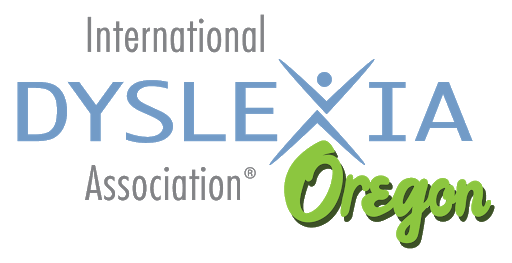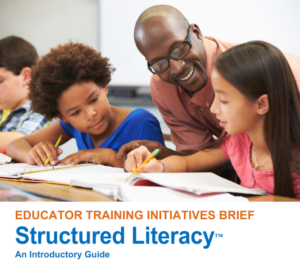What is Structured Literacy?
Structured LiteracyTM instruction is the umbrella term used by the International Dyslexia Association (IDA) to unify and encompass the many evidence-based programs and approaches that are aligned to the Knowledge and Practice Standards. These are effective for students identified with Specific Learning Disability (SLD)/Dyslexia. This approach is beneficial for all children learning to read but is essential for students with SLD/Dyslexia. Structured literacy (SL) teaching is the most effective approach for students who experience unusual difficulty learning to read and spell printed words. The term refers to both the content and methods or principles of instruction.
Want More Info? IDA has released its latest resource, Structured Literacy™: An Introductory Guide. This practitioner-friendly publication will help educators and others better understand the definition, characteristics, and purpose of the term and its affiliated principles and practices.
How is Structured LiteracyTM different from what I am currently using for reading instruction?
The term Structured LiteracyTM has been adopted by The International Dyslexia Association (IDA) and others to describe instructional approaches that teach students explicit and systematic strategies for decoding and spelling words. This term is used to differentiate it from commonly used teaching methods (e.g., Balanced Literacy or Guided Reading) that have NOT proven effective with students who have dyslexia.
The International Dyslexia Association (IDA) examination of Balanced Literacy/Guided Reading offerings have found that many of these programs do not focus on decoding skills that struggling readers need to succeed. The idea is that in order to read, students have to master a progression of skills, beginning with awareness of speech sounds and letters and continuing through comprehension.
Structured Literacy is an approach to reading instruction that is beneficial for both general education students at risk for reading difficulties due to a variety of factors (e.g. low socio-economic status, status as an English learner) and for students with disabilities. This approach is characterized by the provision of systematic, explicit instruction that integrates listening, speaking, reading and writing and emphasizes the structure of language across the speech sound system (phonology), the writing system (orthography), the structure of sentences (syntax), the meaningful parts of words (morphology), the relationships among words (semantics), and the organization of spoken and written discourse.
Structured Literacy is:
- Explicit – concepts are taught using direct teaching of the content or skill to be learned, using clear and unambiguous language.
- Systematic – the elements of the language are taught sequentially with intensive practice and continual feedback.
- Cumulative – lessons build on previous knowledge, moving from simple concepts to more difficult concepts.
- Multisensory – lessons engage the learner in visual, auditory, kinesthetic, and tactile responses (often at the same time)
For more information on Structured Literacy please click here
How do I know if a student in my class needs Structured LiteracyTM?
Screening in early education is paramount. The OR State Dyslexia Guidelines in 2018 introduced universal screening to identify students at risk of dyslexia as early as kindergarten. Screening should cover the areas of phonemic awareness, alphabet knowledge, phoneme-grapheme, and grapheme-phoneme association, single-word decoding of real words and predictable non-words, rapid naming, reading comprehension, and oral reading fluency. This will be the first step in identifying dyslexia in early education for public schools.
Dr. Reid Lyon (1998) in his statement the Overview of NICHD Reading and Literacy Initiatives found:
-
- 5% of students learn to read effortlessly
- 20%-30% learn to read easily with most methods effective
- 30% – 50% find learning to read difficult. Need systematic explicit instruction.
- 5% -20% reading is one of the most difficult tasks that they will have to master throughout their schooling
Note that experts have established that most students will learn to read adequately regardless of the instructional methods used in school. However, some 5% – 20% will not. For dyslexics in particular, explicit, systematic, cumulative and multisensory instruction is necessary if they are to ever become capable readers. These findings are true across race, socioeconomic status, and family background. The earlier a child receives effective instruction the better. Remember, while many children learn to read successfully with approaches such as ‘Guided Reading’ or ‘Balanced Literacy’, research has shown that students with dyslexia need instruction that is:
- explicit, systematic, cumulative and multisensory. This is known as ‘structured literacy‘ instruction.
- intensive, with additional daily practice.
- taught by trained teachers and professionals
As a teacher, what can I do next?
- Host a “Walk in the Shoes of a Dyslexic: Simulation & Student Panel“ event at your school or business. – This can be a powerful way to share the experience students with dyslexia face every day in their classroom.
- Become trained in Structured Literacy – Our website has links to Teacher Presentations & Training
- Familiarize yourself with the Knowledge and Practice Standards for Teachers of Reading. These standards were created by the International Dyslexia Association for classroom teachers and dyslexia specialists.
- Become a Structured LiteracyTM Teacher. This involves passing a standardized test, demonstrating knowledge of the principles of structured literacy.
- Free online training on the principles of Structured Literacy approved by ODE at http://www.readingrockets.org/teaching/reading101-course/welcome-reading-101
- Read Dyslexia in the Classroom: What Every Teacher Needs to Know. This document was developed to give teachers a better understanding of dyslexia.
- Become a member of the International Dyslexia Association (IDA). Become part of a bigger community supporting students with dyslexia.
Contact us for more help!


